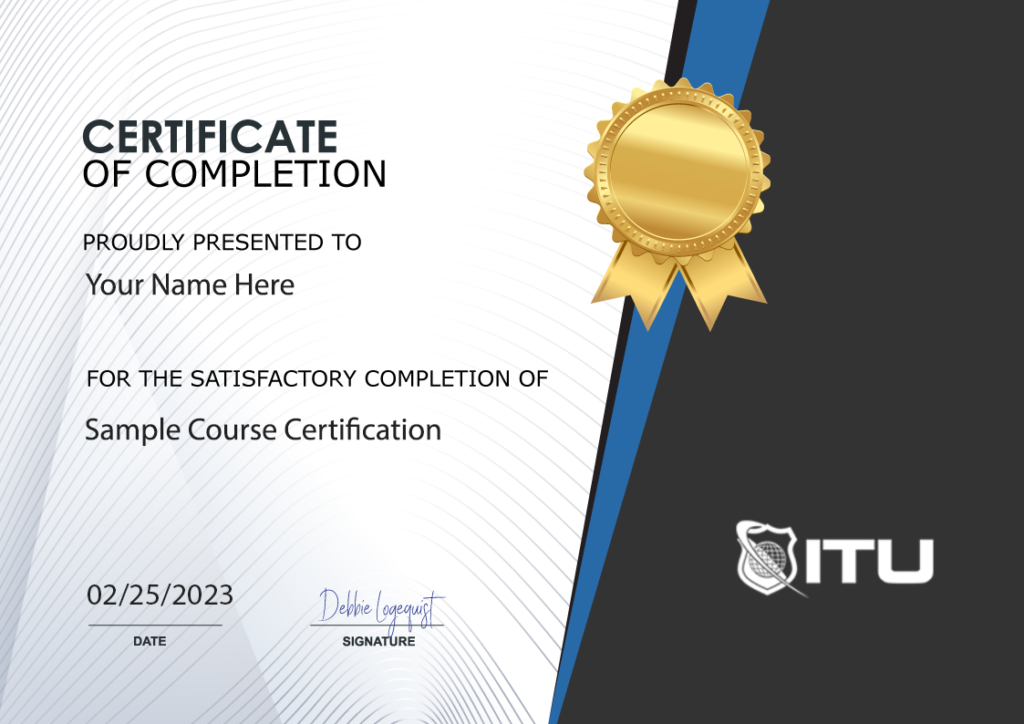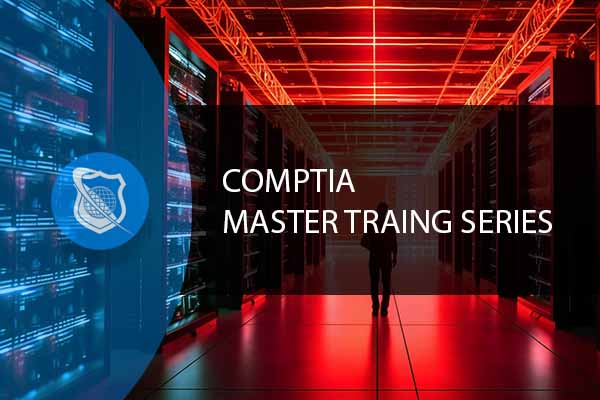CompTIA Certification Training Series
Get all 12 CompTIA courses for one low price in this comprehensive training series. Our CompTIA certification training courses are comprehensive, providing IT professionals with 12 courses that feature the Core Series for A+ certification as well as introducing our innovative IT Fundamentals (ITF+) course! Furthermore, we have PenTest+, Security+, Cloud+ and Network+. For those seeking to become an expert in IT certifications – this is the training product for you!
Included In This Course



Closed Captions



Certificate of Completion
Enhance your IT career with our comprehensive CompTIA certification training. Our all-inclusive package covers essential certifications like CompTIA A+, Network+, Security+, and more, ensuring you’re equipped with the skills in demand in today’s tech industry.
Why Choose Our CompTIA Courses?
- Expert-Led Training: Learn from industry professionals with real-world experience.
- Flexible Learning: Access courses anytime, anywhere, and learn at your own pace.
- Affordable Pricing: Get all CompTIA courses for one low price.
- Comprehensive Content: Detailed modules covering all key concepts and practical applications.
What’s Included in the CompTIA Certification Training
This series includes all the instructional training materials for each course , including:
- 12 Comprehensive CompTIA Courses covering all the most popular CompTIA certifications
- Pre-Recorded Instructor Led Videos
- Study Guides of all Instructional Slides
- Flash Cards
- Games
- Practice Exam Questions/Test and practice tests
Benefits of CompTIA Certification
- Career Advancement: Increase your job prospects and earning potential.
- Industry Recognition: Validate your skills and knowledge with globally recognized certifications.
- Hands-On Learning: Practical exercises and labs to reinforce learning.
What CompTIA Courses Are Included In This Comprehensive Bundle of CompTIA Courses
CompTIA A+ 220-1101 (Core 1)
Brief Description: This course covers the basics of computer hardware and software, providing foundational knowledge for IT professionals. Topics include device setups, multimedia displays, and network theories. Total Hours: 22
Prep Questions: 125
CompTIA A+ 220-1102 (Core 2)
Brief Description: Building on Core 1, this course delves into operating system management, network management tools, and security measures, among other topics. Total Hours: 20
Prep Questions: 124
CompTIA Advanced Security Practitioner (CASP) CAS-003
Brief Description: This course is designed for advanced IT security professionals and covers risk management, enterprise security architecture, and technical integration of enterprise security. Total Hours: 28
Prep Questions: 250
CompTIA Cloud Essentials+ CLO-002
Brief Description: This course provides an understanding of cloud computing concepts and business principles. It’s ideal for those looking to advise on cloud design and migration. Total Hours: 10
Prep Questions: 100
CompTIA Cloud+ CVO-003
Brief Description: A step beyond Cloud Essentials, this course focuses on designing, managing, and operating cloud infrastructures with an emphasis on security, scalability, and reliability. Total Hours: 8
Prep Questions: 50
CompTIA CySA+
Brief Description: This cybersecurity analyst course covers threat and vulnerability management, software and systems security, and incident response. Total Hours: 14
Prep Questions: 100
CompTIA FC0-U61: IT Fundamentals
Brief Description: A beginner’s course that covers IT concepts and terminology, infrastructure, and basic security. Total Hours: 9
Prep Questions: 160
CompTIA Linux+ XK0-004
Brief Description: This course is designed for those who want to master Linux tasks, covering topics like managing permissions, storage, and automating tasks. Total Hours: 24
Prep Questions: 101
CompTIA MB0-001: Mobility+
Brief Description: This course focuses on mobile technologies, covering over-the-air technologies, network infrastructure, and mobile device management. Total Hours: 7
Prep Questions: 59
CompTIA Network+ N10-008
Brief Description: This course is designed for network professionals and covers networking fundamentals, network devices, and network security. Total Hours: 46
Prep Questions: 179
CompTIA PenTest+ PT0-001
Brief Description: This penetration testing course covers the entire pen test engagement process, from passive reconnaissance to reporting. Total Hours: 34
Prep Questions: 249
CompTIA Security+ SY0-701
Brief Description: This course is designed for IT professionals focusing on network security and cybersecurity, covering topics like malware attacks, cryptography, and network security devices. Total Hours: 30
Prep Questions: 112
Each course is designed to prepare you for the respective CompTIA certification exams and is suitable for various levels of IT professionals, from beginners to experts. This CompTIA certification training series contains extensive content that will prepare you for some of the most popular and advanced certifications in the world. It’s a great way for anyone who wants to work in technology to start their career or for current IT Technician to enhance their skills and unleash additional career opportunities.
You can take each CompTIA course at your own pace, study anytime, anywhere, and get prepared to take your certification exams quickly. The bundle also comes with 1 year access to our online learning platform where you can learn from any device, 24/7.
Find out more out CompTIA certifications by visiting the CompTIA website.
You Might Also Like
CompTIA Sec+ Objectives: A Deeper Dive
The CompTIA Sec+ certification is a globally recognized credential that validates an individual’s knowledge and skills in the field of cybersecurity. The primary Sec+ objectives of the CompTIA Security+ certification include: The CompTIA Security+ certification aims to provide a well-rounded understanding of cybersecurity concepts, skills, and best practices.
Schedule a CompTIA Exam : A Quick Reference Guide
Introduction If you’re looking to schedule a CompTIA exam, follow this quick guide to register and schedule your preferred certification exam. CompTIA certifications are a cornerstone in the IT industry, validating a range of skills from basic IT literacy to advanced cybersecurity knowledge.
CompTIA Stackable Certs
What Are CompTIA Stackable Certifications? CompTIA Stackable Certs revolutionize the way professionals enhance their IT expertise, providing a flexible and efficient path to career excellence. Designed by the renowned Computing Technology Industry Association (CompTIA), this cutting-edge certification framework offers a diverse array of benefits for individuals seeking to stand out
Frequently Asked Questions About CompTIA
What is CompTIA?
CompTIA is a non-profit trade association that provides professional certifications for IT professionals. CompTIA certifications are globally recognized and frequently may be required for certain type of roles in the information technology industry.
What are the benefits of getting CompTIA certified?
CompTIA certification can help you stand out in the job market, increase your earning potential, and demonstrate your expertise to employers. A certification help to emphasize your knowledge and credibility.
What types of certifications does CompTIA offer?
CompTIA offers a variety of certifications, including A+, Network+, Security+, Cloud+, and more. Most students study for and maintain multiple different CompTIA certifications. With our Master CompTIA training series, you can pick and choose and find the perfect fit for your interests in information technology.
How can I prepare for a CompTIA certification exam?
You can prepare for a CompTIA certification exam by taking a training course, studying exam objectives, and practicing with sample questions. All of our courses offer in-depth learning from on-demand videos and supporting study materials. Helping students prepare for IT related certifications is our core business.
How much do CompTIA certification exams cost?
The cost of CompTIA certification exams varies depending on the exam. Generally, exams cost between $200 and $400 per exam. Certifications are normally valid for a period of 3 years.
How long does it take to get CompTIA certified?
The time it takes to get CompTIA certified varies depending on the certification and your level of experience. Some certifications may require several months of study and preparation. At ITU, you have the opportunity to study at your own pace. You may view and re-review all materials and practice tests until you feel confident you are ready and prepared to sit for a certification exam.
How long is a CompTIA certification valid for?
CompTIA certifications are typically valid for three years from the date of certification. Historically, CompTIA updates their exam objectives every three years to ensure the content and certifications being provided contain up-to-date information and objectives.
What are the prerequisites for taking a CompTIA certification exam?
Prerequisites vary depending on the certification. Some certifications require no prerequisites, while others may require certain levels of experience or other certifications. With our Mater CompTIA Training series, we have courses that begin at the very beginning and go up to to top. No matter your level of expertise, or lack of it, there is something to be learned for everyone in this series.
Can I take CompTIA exams online?
Yes, many CompTIA exams can be taken online from the comfort of your own home or office.
How do I maintain my CompTIA certification?
You can maintain your CompTIA certification by earning continuing education units (CEUs) or by retaking the certification exam before it expires.
Blogs of Interest Related to This Course
- CompTIA Stackable Certs : Certications To Propel Your IT Career
- CompTIA Network+ Braindumps: Pros and Cons
- 5 Reasons Why You Should Consider CompTIA ITF+ Training
- Breaking Down the Price Tag: Understanding the CompTIA Network+ Cost
- Unlocking Potential: Is the CompTIA Cloud+ Worth It?
- Empowering IT Talent: Implementing a Learning Management System for Employee Training
- Unlock Potential: Highly Effective IT Training for Employees Programs
- All About the CompTIA CSSS: What Every IT Specialist Needs to Know
- Network+ CompTIA Exam Preparation: Tips and Tricks for Success
- A Career In Tech Support: Here is Your Typical Day
Proudly Display
Your Achievement
Upon completion of your training, you’ll receive a personalized certificate of completion to help validate to others your new skills. 
CompTIA A+ 1200 Series (220-1201 & 220-1202) Course Content
Module 4 - Operating Systems
- 4.1 Workstation Operating Systems
- 4.2 Common File System Types
- 4.3 Operating System Installation Types
- 4.4 Operating System Boot Methods
- 4.5 Storage Partitioning
- 4.5.1 Demo - Working with Storage Partitions
- 4.6 Identifying Windows Editions
- 4.7 Windows Upgrades
- 4.8 Windows OS Installations
- 4.9 Using Windows Task Manager
- 4.9.1 Demo - Working with Windows Task Manager
- 4.10 MMC Snap-ins
- 4.10.1 Demo - Working with MMC Snap-ins
- 4.11 Windows Operating System Tools
- 4.12 Microsoft Command Line Tools
- 4.12.1 Demo - Working with Microsoft Command Prompt
- 4.13 Configuring Microsoft Windows Settings
- 4.14 Configuring Windows Power Options
- 4.14.1 Demo - Working with Windows Power Options
- 4.15 Windows File Explorer
- 4.15.1 Demo - Working with File Explorer
- 4.16 Windows Domains vs Workgroups
- 4.17 macOS System Configuration
- 4.17.1 Demo - macOS Features and Tools
- 4.18 Linux Components
- 4.19 Linux Tools
- 4.20 Common Application Installation
Module 1 - Mobile Devices
- 1.0 CompTIA A+ Course Intro
- 1.1 Mobile Device Hardware and Components
- 1.2 Mobile Device Connections and Accessories
- 1.3 Mobile Device Operating Systems
- 1.4 Troubleshooting Mobile Devices
- 1.5 Mobile Device,OS and Application Issues
- 1.6 Mobile Device,OS and Application Security
- 1.7 Identifying Connection Settings in Android
- 1.8 Identifying Connection Settings in iOS
Module 2 - Networking
- 2.1 Network Architecture
- 2.2 Ports and Protocols
- 2.3 Wireless Networking
- 2.4 Network Hosts and Services
- 2.5 DNS and DHCP
- 2.5.1 Demo - Working with DNS and DHCP
- 2.6 VPNs and VLANs
- 2.7 Network Devices
- 2.8 Basic SOHO Configuration
- 2.9 Internet Connections and Network Types
- 2.10 Networking Tools
- 2.11 Networking in Windows
- 2.11.1 Demo - Configuring Networking in Windows
- 2.12 Networking Commands
- 2.12.1 Demo - Working with Networking Commands
- 2.13 Troubleshooting Network Issues
Module 3 - Hardware
- 3.1 Display Components and Attributes
- 3.2 Basic Cables and Connections
- 3.3 Network Cables and Connections
- 3.4 Storage Devices and Connections
- 3.5 Introduction to RAID
- 3.6 Motherboards and Form Factors
- 3.7 Motherboard Connections
- 3.8 BIOS and UEFI
- 3.9 CPUs and CPU Architecture
- 3.10 Expansion Cards
- 3.11 System Cooling
- 3.12 Power Supply Units
- 3.13 Printers and Multifunction Devices
- 3.14 Printer Maintenance
- 3.15 Troubleshooting Computer Components
- 3.16 Troubleshooting Storage and RAID Issues
- 3.17 Troubleshooting Video and Display Issues
- 3.18 Troubleshooting Printer Issues
Module 5 - Virtualization and Cloud Computing
- 5.1 Virtualization Concepts
- 5.1.1 Demo - Working with Virtual Machines
- 5.2 Cloud Computing
- 5.2.1 Demo - Working with the Cloud
- 5.3 Cloud Productivity Tools
Module 6 - Security
- 6.1 Physical Security
- 6.2 Physical Access Security
- 6.3 Logical Security
- 6.4 Windows Security - Firewalls and Antivirus
- 6.4.1 Demo - Working with the Windows Firewalls and Antivirus
- 6.5 Windows Security Users and Groups
- 6.6 Windows Security - NTFS and Share Permissions
- 6.6.1 Demo - Working with NTFS and Share Permissions
- 6.7 Windows Security - Active Directory
- 6.8 Windows Security - Data Encryption
- 6.9 Wireless Security
- 6.10 Malware Types
- 6.11 Malware Detection and Prevention
- 6.12 Social Engineering
- 6.13 Security Threats
- 6.13.1 Demo - Security Vulnerabilities
- 6.14 Malware Removal Process
- 6.15 Workstation Security
- 6.16 Data Destruction Concepts
- 6.17 SOHO Network Security
- 6.18 Browser Security Settings
- 6.19 Troubleshooting PC Security Issues
Module 7 - Operational Procedures
- 7.1 Ticketing Systems
- 7.2 Asset Management
- 7.3 Document Types
- 7.4 Change Management
- 7.5 Workstation Backup and Recovery
- 7.6 Common Safety Procedures
- 7.7 Environmental Impact and Controls
- 7.8 Licensing and Policy Concepts
- 7.9 Communication and Professionalism
- 7.10 Basics of Scripting
- 7.11 Remote Access Technologies
- 7.12 Basics of Artificial Intelligence
- 7.13 Troubleshooting Methodology
- 7.14 CompTIA A+ Course Closeout
CompTIA Pentest+ PT0-003 Course Content
Module 1 - Engagement Management
- 1.1 Pre Engagement Activities
- 1.2 Collaboration and Communication Activities
- 1.3 Testing Frameworks and Methodologies
- 1.3.1 Examining MITRE ATT&CK
- 1.4 Engagement Management Review
Module 2 - Reconnaissance and Enumeration
- 2.1 Passive Reconnaissance
- 2.1.1 Google Hacking
- 2.2 Active Reconnaissance
- 2.2.1 Port Scanning and Fingerprinting
- 2.2.2 Tracing a Network Path with Traceroute
- 2.2.3 Intercepting Data with Wireshark
- 2.2.4 Web Scraping
- 2.3 Enumeration Techniques
- 2.3.1 Directory Enumeration
- 2.3.2 Email Enumeration
- 2.4 Reconnaissance and Enumeration Scripts
- 2.4.1 Using Scripts
- 2.5 Reconnaissance and Enumeration Tools
- 2.5.1 Perform OSINT with Recon ng
- 2.5.2 Adding an API Key to Recon ng
- 2.5.3 Discovering IoT with Shodan
- 2.5.4 Performing WHOIS Lookups
- 2.5.5 Performing DNS Lookups
- 2.5.6 Using NMAP Scripts
- 2.5.7 Performing OSINT with theHarvester
- 2.6 Reconnaissance and Enumeration Review
Module 3 - Vulnerability Discovery and Analysis
- 3.1 Vulnerability Discovery
- 3.1.1 Performing a Vulnerability Scan with OpenVAS
- 3.1.2 Performing Static Code Analysis
- 3.2 Reconnaissance, Scanning and Enumeration Output Analysis
- 3.3 Physical Security
- 3.3.1 Cloning an RFID Badge
- 3.3.2 Cloning NFC with Flipper Zero
- 3.4 Vulnerability Discover and Analysis Review
Module 4 - Attacks and Exploits
- 4.1 Prioritize and Prepare Attacks
- 4.2 Network Attacks
- 4.2.1 Performing an On Path Attack
- 4.2.2 Executing a Network Attack with Metasploit
- 4.2.3 Migrating Meterpreter to Another Process
- 4.2.4 Creating a Malware Dropper with Msfvenom
- 4.2.5 Using Netcat
- 4.2.6 Capturing Files with Wireshark
- 4.3 Authentication Attacks
- 4.3.1 Brute Forcing with Medusa
- 4.3.2 Pass the Hash
- 4.3.3 Password Spraying with Hydra
- 4.3.4 Pass the Token Attack
- 4.3.5 Spoofing Authentication with Responder
- 4.3.6 Cracking Linux Passwords with John the Ripper
- 4.3.7 Hashcat Password Cracking
- 4.4 Host Based Attacks
- 4.4.1 Privilege Escalation with Eternal Blue
- 4.4.2 Log Tampering
- 4.4.3 Pwn a Linux Target from Start to Finish
- 4.5 Web Application Attacks
- 4.5.1 Performing Directory Traversal
- 4.5.2 Grabbing Passwords with SQL Injection
- 4.5.3 SQLi on a Live Website Part 1
- 4.5.4 SQLi on a Live Website Part 2
- 4.5.5 Command Injection
- 4.5.6 Injecting an iFrame with Stored XSS
- 4.5.7 Busting the DOM
- 4.5.8 IDOR Abuse with Burp Suite
- 4.5.9 Web Session Hijacking
- 4.5.10 Parameter Tampering with Burp Suite
- 4.6 Cloud Based Attacks
- 4.6.1 Hacking S3 Buckets
- 4.7 Wireless Attacks
- 4.7.1 WiFi Pumpkin Evil Twin
- 4.7.2 WPA2 Crack Attack
- 4.8 Social Engineering Attacks
- 4.8.1 Phishing for Credentials
- 4.8.2 OMG Cable Baiting
- 4.9 Specialized System Attacks
- 4.9.1 Pwn a Mobile Device
- 4.10 Automated Script Attacks
- 4.11 Attacks and Exploits Review
Module 5 - Post-exploitation and Lateral Movement
- 5.1 Establishing and Maintaining Persistence
- 5.1.1 Creating a Persistent Netcat Back Door
- 5.1.2 Exfiltrating Data with a Scheduled Task
- 5.2 Lateral Movement
- 5.2.1 Preparing to Pivot
- 5.2.2 Lateral Movement through Pivoting
- 5.3 Staging and Exfiltration
- 5.3.1 Hiding Data with Steganography
- 5.3.2 Automatically Exfiltrating Data
- 5.4 Cleanup and Restoration
- 5.5 Post-Exploitation and Lateral Movement Review
Module 6 - Deliverables
- 6.1 Penetration Test Report Components
- 6.2 Report Findings and Recommendations
- 6.2.1 Examining Pentest Reports
- 6.3 Deliverables Review
- 6.4 Course Conclusion
CompTIA Network+ (N10-009) Course Content
Module 1: Networking Concepts
- 1.1 Networking Overview
- 1.1.1-Activity-Creating a Network
- 1.2 OSI and DOD Model
- 1.2.1-Activity-Examining the OSI Layers
- 1.3 Networking Appliances, Applications and Functions
- 1.3.1-Activity-Using Online Proxies
- 1.4 Cloud Concepts and Connectivity
- 1.4.1-Activity-Creating Cloud Resources
- 1.5 Ports, Protocols, Services and Traffic Types
- 1.5.1-Activity-Examining ARP and ICMP
- 1.5.2-Activity-Examining DNS and Ports
- 1.6 Wireless Transmission Media
- 1.6.1-Activity-Configuring-WiFi
- 1.7 Wired Transmission Media and Transceivers
- 1.8 Network Topologies, Architectures and Types
- 1.9a IPv4 Network Addressing - Part 1
- 1.9b IPv4 Network Addressing - Part 2
- 1.9.1-Activity-Configuring Client IP Settings
- 1.9.2-Activity-Subnetting - Delta 128
- 1.9.3-Activity-Subnetting-Delta-64
- 1.9.4-Activity-Subnetting WAN Links
- 1.10a Modern Network Environments - Part 1
- 1.10b Modern Network Environments - Part 2
Module 2: Network Implementation
- 2.1 Implementing Routing Technologies
- 2.1.1-Activity-Setting Up Basic Routing
- 2.1.2-Activity-Adding Static Routes
- 2.1.3-Activity- Configuring Routing Protocols
- 2.1.4-Activity-Configuring Port Address Translation
- 2.2 Configuring Switching Technologies and Features
- 2.2.1-Activity-Connecting Devices with a Switch
- 2.2.2-Activity-Creating VLANs
- 2.2.3-Activity-Voice and Data VLANs
- 2.2.4-Activity-VLAN-Trunking
- 2.2.5-Activity-VLAN Routing
- 2.3 Selecting and Configuring Wireless Devices and Technologies
- 2.3.1-Activity-Creating a WLAN
- 2.4 Physical Installations
- 2.4.1-Activity-Managing Cable
- 2.4.2-Activity-Punching Down Twisted Pair
Module 3: Network Operations
- 3.1 Organizational Processes and Procedures
- 3.2 Network Monitoring Technologies
- 3.2.1-Activity-Exploring SNMP
- 3.3 Disaster Recovery (DR)
- 3.4 IPv4 and IPv6 Network Services
- 3.4.1-Activity-Implementing a DHCP Relay Agent-Part 1
- 3.4.2-Activity-Implementing a DHCP Relay Agent-Part 2
- 3.4.3-Activity-DNS-Part 1
- 3.4.4-Activity-DNS-Part 2
- 3.5 Network Access and Management
Module 4: Network Security
- 4.1a Network Security Concepts - Part 1
- 4.1b Network Security Concepts - Part 2
- 4.1.1-Activity-Exploring Encryption
- 4.1.2-Activity-Applying Authorization
- 4.1.3-Activity-Testing a Honeypot
- 4.2 Network Attacks
- 4.2.1-Activity-Launching a Denial of Service Attack
- 4.2.2-Activity-Phishing for Credentials
- 4.2.3-Activity-Deploying a Malicious Charging Cable
- 4.3 Network Defense
- 4.3.1-Activity-Implementing ACLs
Module 5: Network Troubleshooting
- 5.1 Troubleshooting Methodology
- 5.2 Common Cabling and Physical Interface Issues
- 5.2.1-Activity-Selecting the Right Cable
- 5.2.2-Activity-Crimping an RJ-45 End on a Cable
- 5.3 Network Service Issues
- 5.3.1-Activity-Troubleshooting a Routed Network
- 5.4 Performance Issues
- 5.5 Troubleshooting Tools and Protocols
- 5.5.1-Activity-Using Command Line Commands
- 5.5.2-Activity-Using NSLOOKUP and DIG
- 5.5.3-Activity-Using NMAP
- 5.5.4-Activity-Troubleshooting Using CDP and LLDP
- 5.5.5-Activity-Testing a cable
- 5.5.6-Activity-Toning a cable
- 5.5.7-Activity-Using a Spectrum Analyzer
- 5.5.8-Activity-Testing a Fiber Optic Cable
- 5.5.9-Activity-Using Network Device Commands
- 5.6 Course Closeout
CompTIA Linux+ (XK0-005) Course Content
Module 1: Performing Basic Linux Tasks
- 1.1 Introduction to Linux XK0-005
- 1.2 Instructor Introduction
- 1.3 Course Introduction
- 1.4 Identify the Linux Design Philosophy
- 1.5 Enter Shell Commands
- 1.6 Shell Commands Activity
- 1.7 Get Help with Linux
Module 2: Managing Users and Groups
- 2.1 Assume Superuser Privileges
- 2.2 Create, Modify, and Delete Users
- 2.3 Create, Modify, and Delete Groups
- 2.4 Query Users and Groups
- 2.5 Configure Account Profiles
Module 3: Managing Permissions and Ownership
- 3.1 Modify File and Directory Permissions
- 3.2 Modify File and Directory Ownership
- 3.3 Configure Special Permissions and Attributes
- 3.4 Troubleshoot Permissions Issues
Module 4: Managing Storage
- 4.1 Create Partitions
- 4.2 Manage Logical Volumes
- 4.3 Mount File Systems
- 4.4 Manage File Systems
- 4.5 Navigate the Linux Directory Structure
- 4.6 Troubleshoot Storage Issues
- 4.7 Container Storage Management
- 4.8 Advanced Data Management and Security for Containers
Module 5: Managing Files and Directories
- 5.1 Create and Edit Text Files
- 5.2 Search for Files
- 5.3 Perform Operations on Files and Directories
- 5.4 Process Text Files
- 5.5 Manipulate File Output
Module 6: Managing Kernel Modules
- 6.1 Explore the Linux Kernel
- 6.2 Install and Configure Kernel Modules
- 6.3 Monitor Kernel Modules
Module 7: Managing the Linux Boot Process
- 7.1 Configure Linux Boot Components
- 7.2 Configure GRUB
Module 8: Managing System Components
- 8.1 Configure Localization Options
- 8.2 Configure GUIs
- 8.3 Manage Services
- 8.4 Troubleshoot Process Issues
- 8.5 Troubleshoot CPU and Memory Issues
- 8.6 - Troubleshooting With systemd
Module 9: Managing Devices
- 9.1 Identify the Types of Linux Devices
- 9.2 Configure Devices
- 9.3 Monitor Devices
- 9.4 Troubleshoot Hardware Issues
Module 10: Managing Networking
- 10.1 Identify TCP-IP Fundamentals
- 10.2 Identify Linux Server Roles
- 10.3 Connect to a Network
- 10.4 Configure DHCP and DNS Client Services
- 10.5 Configure Cloud and Virtualization Technologies
- 10.6 Troubleshoot Networking Issues
Module 11: Managing Packages and Software
- 11.1 Identify Package Managers
- 11.2 Manage RPM Packages with YUM
- 11.3 Manage Debian Packages with APT
- 11.4 Configure Repositories
- 11.5 Acquire Software
- 11.6 Build Software from Source Code
- 11.7 Troubleshoot Software Dependency Issues
Module 12: Securing Linux Systems
- 12.1 Implement Cybersecurity Best Practices
- 12.2 Implement Identity and Access Management Methods
- 12.3 Configure SELinux or AppArmor
- 12.4 Configure Firewalls
- 12.5 Implement Logging Services
- 12.6 Back Up, Restore, and Verify Data
- 12.7 NFTables - Setting Up Advanced Firewalls
Module 13: Working with Bash Scripts
- 13.1 Customize the Bash Shell Environment
- 13.2 Identify Scripting and Programming Fundamentals
- 13.3 Write and Execute a Simple Bash Script
- 13.4 Incorporate Control Statements in Bash Scripts
Module 14: Automating Tasks
- 14.1 Schedule Jobs
- 14.2 Implement Version Control Using Git
- 14.3 Identify Orchestration Concepts
Module 15: Installing Linux
- 15.1 Prepare for Linux Installation
- 15.2 Perform the Installation
Module 16 - Working With Modern IT Infrastruture
- 16.1 - Infrastruture As Code (IAC)
- 16.2 - Containers, Cloud, and Orchestration Concepts
- 16.3 - Container Management
- 16.4 - Container and Cloud Networking Basics
CompTIA Tech+ (FC0-U71) Certification Preparation Course Content
Module 1 - IT Concepts and Terminology
- 1.1 - Introduction to Tech+
- 1.2 - Understanding Notational Systems
- 1.3 - The Basics of Computing
- 1.4 - Comparing Units of Measure
- 1.5 - Troubleshooting Methodology, Cases and Tips
Module 2 - Infrastructure
- 2.1 - Introduction to Infrastructure
- 2.2 - Types of Computing Devices
- 2.3 - Internal Components of A Computer
- 2.4 - Types of Storage
- 2.5 - Peripheral Devices and Installation
- 2.6 - Virtualization and Cloud Technologies
- 2.7 - Common Internet Service Types
Module 3 - Networking Fundaments
- 3.1 - Introduction to Networking
- 3.2 - Core Principles of Computer Networking
- 3.3 - Network Ports
- 3.4 - Network Addresses and Identifiers
- 3.5 - Network Models and Types
- 3.6 - Networking Devices and Connectors
- 3.7 - Small Wireless Networks
Module 4 - Operating Systems
- 4.1 Workstation Operating Systems
- 4.2 Common File System Types
- 4.3 Operating System Installation Types
- 4.4 Operating System Boot Methods
- 4.5 Storage Partitioning
- 4.5.1 Demo - Working with Storage Partitions
- 4.6 Identifying Windows Editions
- 4.7 Windows Upgrades
- 4.8 Windows OS Installations
- 4.9 Using Windows Task Manager
- 4.9.1 Demo - Working with Windows Task Manager
- 4.10 MMC Snap-ins
- 4.10.1 Demo - Working with MMC Snap-ins
- 4.11 Windows Operating System Tools
- 4.12 Microsoft Command Line Tools
- 4.12.1 Demo - Working with Microsoft Command Prompt
- 4.13 Configuring Microsoft Windows Settings
- 4.14 Configuring Windows Power Options
- 4.14.1 Demo - Working with Windows Power Options
- 4.15 Windows File Explorer
- 4.15.1 Demo - Working with File Explorer
- 4.16 Windows Domains vs Workgroups
- 4.17 macOS System Configuration
- 4.17.1 Demo - macOS Features and Tools
- 4.18 Linux Components
- 4.19 Linux Tools
- 4.20 Common Application Installation
Module 5 - Software and Applications
- 5.1 - Common Software Applications
- 5.2 - Productivity Software
- 5.3 - Business and Enterprise Software
- 5.4 - Manging Software
- 5.5 - Trusted Software Sources
Module 6 - Web Browsing, Configuration & Security
- 6.1 - Introduction To Web Browsing
- 6.2 - Browser Settings, Configuration and Maintenance
- 6.3 - Secure Web Browsing
- 6.4 - Protecting Your Privacy
Module 7 - Software Development Concepts
- 7.1 - Introduction to Programming
- 7.2 - Programming Tools
- 7.3 - Programming Organization and Logic Flows
- 7.4 - Understanding Programming Language Categories
- 7.5 - Code Maintenance, Version Control Systems and Branching
- 7.6 - Fundamental Data Types and Their Characteristics
Module 8 - Data and Database Fundamentals
- 8.1 - Introduction to Databases and the Value of Data
- 8.2 - Database Concepts and Structures
- 8.3 - Working with Relational Databases
- 8.4 - Database Operations and Access
- 8.5 - Database Backup and Recovery
Module 9 - Security: Keeping Things Safe
- 9.1 - Basic Security Concepts and Strategies
- 9.2 - Identifying Common Security Threats
- 9.3 - Securing Devices and Networks
- 9.4 - Security Tools and Software
- 9.5 - Encryption and Data Protection
Module 10 - AI Uses and Impact
- 10.1 - The Impact and Use of AI
- 10.2 - Course Closeout
CompTIA Security+ SY0-701 Course Content
Module 1 - SY0-701 General Security Concepts
- 1.0 Introduction to the Course
- 1.1 Fundamental Security Concepts
- 1.2 Zero Trust
- 1.3 Deception and Disruption
- 1.3.1 ACTIVITY - Testing a Honeypot
- 1.4 Security Controls
- 1.5 Change Management and Security
- 1.6 Cryptography Basics
- 1.6.1 ACTIVITY - Examining Symmetric Encryption
- 1.7 Asymmetric Encryption
- 1.7.1 ACTIVITY - Exploring Asymmetric Encryption
- 1.8 Hashing
- 1.8.1 ACTIVITY - Verifying Integrity with Hashing
- 1.9 Digital Certificates
- 1.10 Public Key Infrastructure
- 1.11 Data and Keys
- 1.12 Crypto Implementations
- 1.13 Blockchain
- 1.14 Non-Cryptographic Data Protection
Module 2 - SY0-701 Threats, Vulnerabilities, and Mitigations
- 2.1 Threat Actors and Motivations
- 2.2 Threat Vectors
- 2.2.1 ACTIVITY - O.MG Cable Baiting
- 2.2.2 O.MG-No Cable
- 2.3 Social Engineering
- 2.4 Operating System Vulnerabilities and Attacks
- 2.5 Application Vulnerabilities and Attacks
- 2.5.1 ACTIVITY - Performing a Buffer Overflow
- 2.6 Web-based Vulnerabilities and Attacks
- 2.6.1 ACTIVITY - Abusing Unsanitized Input
- 2.6.2 ACTIVITY - Grabbing Passwords with SQL Injection
- 2.6.3 ACTIVITY - Swiping a Token with XSS
- 2.7 Other Vulnerabilities
- 2.8 Common Malicious Activity Indicators
- 2.9 Insider Threat Indicators
- 2.10 Social Engineering Indicators
- 2.10.1 ACTIVITY - Capturing Credentials through Social Engineering
- 2.11 Malware Activity Indicators
- 2.12 Operating System Attack Indicators
- 2.13 Application Attack Indicators
- 2.13.1 ACTIVITY - Recognizing Directory Traversal
- 2.14 Physical Attack Indicators
- 2.14.1 ACTIVITY - Quickly Cloning an RFID Badge
- 2.15 Network Attack Indicators
- 2.15.1 ACTIVITY - Crashing a Target with DoS
- 2.16 Cryptographic Attack Indicators
- 2.17 Password Attack Indicators
- 2.17.1 ACTIVITY - Password Cracking
- 2.18 Network Segmentation
- 2.19 Access Control
- 2.20 Enterprise Device Hardening
Module 3 - SY0-701 Security Architecture
- 3.1 Network Segmentation
- 3.1.1 ACTIVITY - Segementing a Network
- 3.2 High Availability
- 3.3 Virtualization
- 3.3.1 ACTIVITY - Deploying Docker Containers
- 3.4 Cloud
- 3.5 Serverless Computing
- 3.6 IoT
- 3.7 ICS SCADA
- 3.7.1 ACTIVITY - Operating a SCADA System
- 3.8 RTOS and Embedded Systems
- 3.9 Reducing the Attack Surface
- 3.10 Firewalls
- 3.11 IDS IPS.mp4
- 3.12 Secure Communications - Access
- 3.13 Port Security
- 3.14 SD-WAN and SASE
- 3.15 Data Classifications
- 3.16 Protecting Data Types
- 3.17 Data Considerations
- 3.18 Redundancy
- 3.19 Alternate Sites
- 3.20 Multiple Platforms
- 3.21 Business Continuity
Module 4 - SY0-701 Security Operations
- 4.1 Secure Baselines
- 4.2 Attack Surface Reduction
- 4.3 Wireless Installation
- 4.4 Wireless Security Settings
- 4.5 Mobile Solutions
- 4.5.1 ACTIVITY - Pwning a Mobile Device
- 4.6 Application Security Management
- 4.7 Asset Management
- 4.8 Vulnerability Management
- 4.9 Monitoring Activities
- 4.10 Monitoring Tools
- 4.10.1 ACTIVITY - Scanning a Network for Vulnerabilities
- 4.11 Firewall Configuration
- 4.11.1 ACTIVITY - Configuring Firewall Rules
- 4.12 Intrusion Detection Configuration
- 4.13 Web Traffic Filtering
- 4.14 Operating System Policy
- 4.14.1 ACTIVITY - Examining Windows Group Policy
- 4.15 Network Service Security
- 4.16 Data Loss Protection
- 4.16.1 ACTIVITY - Checking File Integrity
- 4.17 Network Access Control
- 4.17.1 ACTIVITY - Require Multifactor Authentication
- 4.18 Identity Management
- 4.19 Access Management
- 4.19.1 ACTIVITY - Implementing Access Control
- 4.20 Security Automation
- 4.21 Incident Response
- 4.22 Digital Forensics
Module 5 - SY0-701 Security Program Management and Oversight
- 5.1 Elements of Effective Security Governance
- 5.2 Elements of the Risk Management Process
- 5.3 Third Party Risk Assessment and Management
- 5.3.1 ACTIVITY - Analyzing the Solar Winds Supply Chain Failure
- 5.4 Effective Security Compliance
- 5.5 Audits and Assessments
- 5.5.1 ACTIVITY - Conducting OSINT
- 5.5.2 ACTIVITY - Performing Active Reconnaissance
- 5.6 Security Awareness Practices
- 5.7 Course Outro
CompTIA Cybersecurity Analyst CySA+ (CS0-003) Course Content
Module 1 - CompTIA CySA+ CS0-003 Basics
- 1.1 Course Introduction
- 1.2 Instructor Introduction
- 1.3 What is CySA
- 1.4 Exam Objectives
- 1.5 Cybersecurity Pathway
- 1.6 DoD Baseline Certfication
Module 2 - CompTIA CySA+ CS0-003 Domain 1 - Security Operations
- 2.1 Domain 1 - Security Operations Overview
- 2.2 System and Network Architecture Concepts in Security Operations
- 2.3 Log Files
- 2.4 Operating Systems
- 2.5 Infrastructure Concepts
- 2.6 Network Architecture
- 2.7 Software Defined Networking
- 2.8 Whiteboard Discussion - Network Architectures
- 2.9 Identity and Access Management IAM Basics
- 2.10 Demonstration - IAM
- 2.11 Encryption
- 2.12 Sensitive Data
- 2.13 1.2 Analyze Indicators of Potentially Malicious Activity
- 2.14 Network Attack
- 2.15 Host Attacks
- 2.16 Application Related Attacks
- 2.17 Social Attacks
- 2.18 Tools or Techniques to Determine Malicious Activity Overview
- 2.19 Tools and Toolsets For Identifying Malicious Activity
- 2.20 Common Techniques
- 2.21 Programming Concerns
- 2.22 Threat-Intelligence and Threat-Hunting Concepts Overview
- 2.23 Threat Actors
- 2.24 Tactics, Techniques and Procedures
- 2.25 Confidence Levels IOC
- 2.26 Collection Sources
- 2.27 Threat Intelligence
- 2.28 Cyber Response Teams
- 2.29 Security Operations
- 2.30 Standardized Processes and Operations
- 2.31 Security Operations Tools and Toolsets
- 2.32 Module 2 Review
Module 3 - CompTIA CySA+ CS0-003 Domain 2 - Vulnerability Management
- 3.1 Domain 2 - Vulnerability Management Overview
- 3.2 Vulnerability Discovery and Scanning
- 3.3 Asset Discovery and Scanning
- 3.4 Industry Frameworks
- 3.5 Mitigating Attacks
- 3.6 CVSS and CVE
- 3.7 Common Vulnerability Scoring System (CVSS) interpretation
- 3.8 CVE Databases
- 3.9 Cross Site Scripting (XSS)
- 3.10 Vulnerability Response, Handling, and Management
- 3.11 Control Types (Defense in Depth, Zero Trust)
- 3.12 Patching and Configurations
- 3.13 Attack Surface Management
- 3.14 Risk Management Principles
- 3.15 Threat Modeling
- 3.16 Threat Models
- 3.17 Secure Coding and Development (SDLC)
- 3.18 Module 3 Review
Module 4 - CompTIA CySA+ CS0-003 Domain 3 - Incident Response and Management
- 4.1 Domain 3 - Incident Response and Management Overview
- 4.2 Attack Methodology Frameworks
- 4.3 Cyber Kill Chain
- 4.4 Frameworks to Know
- 4.5 Incident Response and Post Reponse
- 4.6 Detection and Analysis
- 4.7 Post Incident Activities
- 4.8 Containment, Eradication and Recovery
- 4.9 Module 4 Review
Module 5 - CompTIA CySA+ CS0-003 Domain 4 - Reporting and Communication
- 5.1 Domain 4 - Reporting and Communication Overview
- 5.2 Reporting Vulnerabilities Overview
- 5.2.1 Vulnerability Reporting
- 5.3 Compliance Reports
- 5.4 Inhibitors to Remediation
- 5.5 Metrics and KPI's
- 5.6 Incident Response Reporting and Communications Overview
- 5.7 Incident Declaration
- 5.8 Communication with Stakeholders
- 5.9 Root Cause Analysis
- 5.10 Lessons Learned and Incident Closure
- 5.11 Module 5 Review
Module 6 - CompTIA CySA+ CS0-003 - Course Closeout
- 6.1 Course Closeout Overview
- 6.2 Practice Questions
- 6.3 Exam Process
- 6.4 Continuing Education
- 6.5 Course Closeout
CompTIA Cloud+ (CV0-003) Course Content
Module 1 - CompTIA Cloud+ CV0-003 Course Overview
- 1.0 Course Trailer
- 1.1 Course Overview
- 1.2 What is the Cloud + Exam
- 1.3 Cloud + Domain Obectives Overview
- 1.4 CompTIA Certification Pathways
- 1.5 DoD and ISO Requirements
Module 2 - General Cloud Knowledge
- 2.1 Domain Overview
- 2.2 Compare and Contrast Cloud Models
- 2.3 Cloud Computing Defined
- 2.4 Deployment Models
- 2.5 Service Models
- 2.6 Cloud Characteristics
- 2.7 Cloud Roles
- 2.8 Evaluate Cloud Providers and Services
- 2.9 Regions and Zones
- 2.10 Shared Responsibility Model
- 2.11 Demonstration - AWS Shared Security Model
- 2.12 Comparing Cloud to Virtualization
- 2.13 Comparing Cloud to On Premises
- 2.14 What is a Virtual Machine
- 2.15 Demonstration - Deploy a Cloud VM (AWS EC2)
- 2.16 What is an API
- 2.17 Capacity Planning Factors
- 2.18 Licensing, Factors, Requirements and Planning
- 2.19 Capacity Planning
- 2.20 Demonstration - AWS Trusted Advisor
- 2.21 HA and Scaling
- 2.22 High Availability and Disaster Recovery
- 2.23 Virtual, System and Communication Protection
- 2.24 Hypervisor Affinity
- 2.25 Analyze the solution design
- 2.26 Business Requirements
- 2.27 Business Enablers
- 2.28 Demonstration -AWS Well Architected Tool
- 2.29 Testing Techniques
- 2.30 Testing Success Factors
- 2.31 Module Review Questions
- 2.32 Module Summary Review
Module 3 - Cloud Security
- 3.1 Domain Overview
- 3.2 Configure Identity and Access Management
- 3.3 Identification and Authorization Management (IAM)
- 3.4 SDLC
- 3.5 Directory Services
- 3.6 Security and Access Controls
- 3.7 Federation
- 3.8 SSO and MFA
- 3.9 Certificates and Key Management
- 3.10 Secure a Network in a Cloud Environment
- 3.11 Networking Devices and Segmentation
- 3.12 Firewalls and Proxies
- 3.13 NAT and PAT
- 3.14 Secure Network Configurations (Tunnelling and Encryption)
- 3.15 Demo Hardening and Configuration Changes
- 3.16 OS Application Controls and Security Credentials
- 3.17 Policies and Permissions
- 3.18 Host and Network Protections (HIDSIPS)
- 3.19 Virtualization Security
- 3.20 Monitoring
- 3.21 Data Security and Compliance Controls in Cloud Environments
- 3.22 Structured, Unstructured and Semi Structured Data
- 3.23 Data Classification and Labeling
- 3.24 Data Loss Prevention
- 3.25 Demonstration - Google Cloud DLP
- 3.26 Chain of Custody and Non-Repudiation
- 3.27 Discussion - CASB
- 3.28 Module Summary Review
- 3.29 Module Review Questions
Module 4 - Cloud Deployment
- 4.1 Domain Overview
- 4.2 Integrate Components into Cloud Solutions
- 4.3 Subscription Services
- 4.4 Demonstration - Provision VM
- 4.5 Cloud Infrastructure Components
- 4.6 Whiteboard - Design a Resilent AWS Cloud Architecture
- 4.7 Containers
- 4.8 Microservices
- 4.9 Demonstration - Deploy Containers
- 4.10 Scaling
- 4.11 Provision Storage
- 4.12 Cloud Storage Protocols
- 4.13 Storage Features
- 4.14 Storage Cost Considerations
- 4.15 Storage Performance
- 4.16 RAID and Tiering
- 4.17 Demonstration - AWS S3
- 4.18 Deploy Cloud Networking Solutions
- 4.19 Connecting to The Cloud
- 4.20 Network Protocols
- 4.21 VPNS, VPC and Connectivity
- 4.22 Whiteboard - AWS VPC Connectivity
- 4.23 Demonstration - AWS VPC
- 4.24 Software Defined Networking (SDN)
- 4.25 Compute Sizing
- 4.26 Virtualization Considerations
- 4.27 Resource Rightsizing (CPU, Memory, etc)
- 4.28 Module Summary Review
- 4.29 Module Review Questions
Module 5 - Operations and Support
- 5.1 Domain Overview
- 5.2 Logging Monitoring and Alerting
- 5.3 Logging, Storage and Analysis of Data Events
- 5.4 Monitoring Cloud Resources
- 5.5 Service Level Agreements
- 5.6 Demonstration - SLAs in AWS
- 5.7 Maintain Efficient Operations of a Cloud Environment
- 5.8 Lifecycle Management
- 5.9 Change and Asset Management
- 5.10 SOP, Patching and Upgrades
- 5.11 Orchestration and Automation
- 5.12 Orchestration or Automation
- 5.13 DevOps, IaC and CICD Pipelines
- 5.14 Playbooks and Templates
- 5.15 Backup and Restore Operations
- 5.16 Backup Types, Objects, Targets
- 5.17 Restore and Recovery
- 5.18 Module Summary Review
- 5.19 Module Review Questions
Module 6 - Troubleshooting
- 6.1 Domain Overview
- 6.2 Troubleshooting Methodology Intro
- 6.3 Troubleshooting Methodology
- 6.4 Troubleshoot Security Issues
- 6.5 Cloud Attacks
- 6.6 Security Groups and NACLS
- 6.7 Troubleshoot Deployment Issues
- 6.8 Discussion Site Connectivity Issues
- 6.9 Discussion - Capacity Issues
- 6.10 Connectivity Issues
- 6.11 Connectivity Troubleshooting Tools
- 6.12 Demonstration - GCP AWS Azure Latency Test
- 6.13 Module Summary Review
- 6.14 Module Review Questions
Module 7 - Course Closeout
- 7.1 Exam Preparation
- 7.2 Course Closeout
CompTIA Network+ N10-008 Course Content
Module 0 - Course introduction
- 0.1 Instructor Intro
- 0.2 Course Overview
Module 1 - Networking Fundamentals
- 1.1 Intro to Networking
- 1.1.1 Activity: Creating a Network
- 1.2 Common Terminology
- 1.2.1 Activity: Examining Ports and Sockets
- 1.3 OSI Model
- 1.4 DoD Model
- 1.4.1 Activity: Examining Network Layers
- 1.5 TCP, UDP, IP
- 1.5.1 Activity: Examining TCP
- 1.5.2 Activity: Examining UDP
- 1.5.3 Activity: Examining IP
- 1.6 ICMP, IGMP, ARP
- 1.6.1 Activity: Examining ICMP
- 1.6.2 Activity: Examining ARP
- 1.6.3 Activity: Examining IGMP
- 1.7 Network Topologies
- 1.8 Network Types
- 1.9 Part 1: Network Characteristics
- 1.9 Part 2: Network Characteristics
- 1.10 Module 1 outro
Module 2 - Cables and Connectors
- 2.1 Ethernet Standards
- 2.2 Copper Cable Types
- 2.3 Fiber Optic Cable Types
- 2.4 Connector Types
- 2.4.1 Activity: Selecting the Right Cable
- 2.5 Media Converters and Transceivers
- 2.6 Cable Management
- 2.7 Module 2 Outro
Module 3 - Internet Protocol (IP)
- 3.1 IPv4 Basics
- 3.2 IP Packet and Interface Types
- 3.2.1 Activity: Configuring Client IP Settings
- 3.3 Binary Numbering System
- 3.4 Classful and Classless Addressing
- 3.5 Understanding CIDR Notation
- 3.6 IPv4 Subnetting Method
- 3.7 Verifying with Binary
- 3.8 Finding Subnet IDs
- 3.8.1 Activity: Subnetting a Class C Network
- 3.9 The Delta in Action
- 3.9.1 Activity: Subnetting With the Delta
- 3.10 Subnetting Based on Hosts
- 3.11 Subnetting in Other Octets
- 3.12 Supernetting
- 3.12.1 Activity: Supernetting
- 3.13 IPv6
- 3.14 IPv4 - IPv6 Transition Mechanisms
- 3.15 Module 3 Outro
Module 4 - Layer 7 Protocols
- 4.1 Remote Control Protocols
- 4.2 File Sharing Protocols
- 4.3 Web Protcols
- 4.4 Email Protocols
- 4.5 Database Protocols
- 4.6 Voice Protocols
- 4.7 Security Protocols
- 4.8 Management Protocols
- 4.9 Module 4 Outro
Module 5 - Network Services
- 5.1 DHCP
- 5.1.1 Activity: Configuring DHCP
- 5.1.2 Activity: Configuring a DHCP Relay Agent
- 5.2 DNS
- 5.2.1 Activity: Configuring DNS - Part 1
- 5.2.2 Activity: Configuring DNS - Part 2
- 5.3 NTP
- 5.4 Corporate and Datacenter Network Architecture
- 5.5 Cloud Concepts and Connectivity Options
- 5.6 Module 5 Outro
Module 6 - Networking Devices
- 6.1 Introductory Concepts
- 6.2 Repeaters and Hubs
- 6.2.1 Activity: Connecting Devices with a Hub
- 6.3 Bridges and Switches
- 6.3.1 Activity: Connecting Devices with a Switch
- 6.4 Routers and Multilayer Switches
- 6.5 Security Devices
- 6.6 Modems
- 6.7 Module 6 Outro
Module 7 - Networked Devices
- 7.1 IP Devices
- 7.2 IoT
- 7.2.1 Activity - Programming IoT Devices
- 7.3 ICS/SCADA
- 7.4 Module 7 Outro
Module 8 - Routing and Bandwidth Management
- 8.1 Routing Basics
- 8.1.1 Activity: Configuring Static Routes
- 8.2 Packet Delivery on the Same Network
- 8.3 IP Routing Across a Single Router
- 8.4 IP Routing Across Multiple Hops
- 8.4.1 Activity: Static Routes - CHALLENGE
- 8.5 Route Selection
- 8.6 RIP
- 8.6.1 Activity: Configuring RIP - CHALLENGE
- 8.7 OSPF
- 8.8 EIGRP
- 8.9 BGP
- 8.10 NAT/PAT
- 8.11 Bandwidth Management (with Module 8 Outro)
Module 9 - Ethernet Switching
- 9.1 Ethernet Basics
- 9.2 Switching Overview
- 9.2.1 Activity: Examining a MAC Table
- 9.3 VLANs
- 9.3.1 Activity: Creating VLANs
- 9.4 VLAN Trunking
- 9.4.1 Activity: Configuring VLAN Trunking
- 9.5 VLAN Routing
- 9.5.1 Activity: Configuring VLAN Routing
- 9.6 Contention Management
- 9.7 Switchport Configuration (with Module 9 Outro)
Module 10 - Wireless Technologies
- 10.1 Wireless Overview
- 10.2 Radio Basics
- 10.3 Modulation
- 10.4 Wi-Fi Standards
- 10.5 Antennas
- 10.6 Wi-Fi Service Sets
- 10.7 Wi-Fi Security
- 10.8 Cellular
Module 11 Network Performance
- 11.1 Monitoring Performance
- 11.2 Common Metrics
- 11.2.1 Activity: Examining Interface Statistics
- 11.3 SNMP
- 11.4 Netflow
- 11.5 Network Security Monitoring (with Module 11 Outro)
Module 12 High Availability and Disaster Recovery
- 12.1 HA and DR Concepts
- 12.2 High Availability Mechanisms
- 12.3 Disaster Recovery Mechanisms
- 12.4 Facility and Infrastructure Support (with Module 12 Outro)
Module 13 Organizational Documents
- 13.1 Plans and Procedures
- 13.2 Security Policies
- 13.3 Loss Prevention
- 13.4 Common Agreements
- 13.5 Common Documentation
- 13.6 Structured Cabling - MDF and IDF
- 13.7 Horizontal and Vertical Cabling
- 13.7.1 Activity - Implementing Cable Management
- 13.8 Labeling
- 13.9 Surveys and Assessments (with Module 13 Outro)
Module 14 Network Security
- 14.1 Common Security Concepts
- 14.2 Common Attack Types
- 14.3 Spoofing-based Attacks
- 14.4 Hijacking and MITM
- 14.5 Social Engineering
- 14.6 Network Segmentation
- 14.7 Private VLANs
- 14.8 Single Organization Authentication
- 14.9 Extending Authentication
- 14.10 Authorization
- 14.11 Network Device Hardening
- 14.12 Wireless Security
- 14.13 Remote Access Security
- 14.14 IoT Security
- 14.15 Physical Security (with Module 14 Outro)
Module 15 Network Troubleshooting
- 15.1 Troubleshooting Methodology
- 15.2 Physical Connectivity Issues
- 15.3 Hardware Testing Tools
- 15.3.1 Activity - Testing an Ethernet Cable
- 15.3.2 Activity - Crimping on an RJ-45 Connector
- 15.3.3 Activity - Punching Down Twisted Pair
- 15.3.4 Activity - Using a Telephone Toner
- 15.4 Understanding Electricity
- 15.4.1 Activity - Checking Cable Continuity
- 15.4.2 Activity - Testing DC Voltage
- 15.4.3 Activity - Testing AC Voltage
- 15.5 Twisted Pair Pinout Problems
- 15.6 Twisted Pair Termination Problems
- 15.7 Repairing Damaged Twisted Pair Cable
- 15.8 Fiber Optic Connectivity Issues
- 15.8.1 Activity - Testing a Fiber Optic Cable
- 15.9 Common Port Problems
- 15.9.1 Working with Ports and Their Devices
- 15.10 Common Software Testing Tools
- 15.10.1 Activity - Scanning for Open Ports
- 15.11 Common Command Line Utilities
- 15.12 Troubleshooting Basic IP Networking Issues
- 15.13 Common Switching Issues
- 15.14 Switching Test Tools and Techniques
- 15.15 Common IP Routing Issues
- 15.16 Wi-Fi Access Point Issues
- 15.17 Wirelss Interference
- 15.17.1 Activity - Using a Spectrum Analyzer
- 15.18 Wireless Antenna Issues
- 15.18.1 Activity - Configuring a Wi-Fi Router
- 15.19 WAP Placement Strategies
- 15.20 Infrastructure Service Issues (DHCP)
- 15.21 Infrastructure Service Issues (DNS)
- 15.22 Infrastructure Service Issues (NTP)
- 15.23 Fireall / ACL Issues
- 15.24 VPN Issues
- 15.25 Additional Network Security Troubleshooting and Tips
- 15.26 Advanced Networking Issues
- 15.27 Troubleshooting Server Services (with Module 15 Outro)
- CompTIA Network+ N10-008 Course Outro
CompTIA Cloud Essentials+ (CLO-002) Course Content
Module 1: Understanding Cloud Computing Concepts
- Course Intro
- Understand Basic Cloud Concepts and Terms Pt 1
- Understand Basic Cloud Concepts and Terms Pt 2
- Understand Basic Cloud Concepts and Terms Activity
- Identify Cloud Network and Cloud Storage Technologies
- Identify Cloud Network and Cloud Storage Technologies Activity
- Recognize Cloud Design Aspects
- Recognize Cloud Design Aspects Activity
Module 2: Applying Cloud Business Principles
- Relate Cloud Concepts to Business Principles
- Relate Cloud Concepts to Business Principles Activity
- Establish Cloud Vendor Relations
- Establish Cloud Vendor Relations Activity
- Distinguish the Financial Aspects of Engaging a Cloud Service Provider
- Distinguish the Financial Aspects of Engaging a Cloud Service Provider Activity
- Report Financial Expenditures
- Report Financial Expenditures Activity
Module 3: Advising a Cloud Design and Migration
- Relate Cloud Concepts to Cloud Design and Migration
- Relate Cloud Concepts to Cloud Design and Migration Activity
- Use Cloud Assessments
- Use Cloud Assessments Activity
- Manage Cloud Design
- Manage Cloud Design Activity
- Compare Cloud Migration Approaches
- Compare Cloud Migration Approaches Activity
- Identity Benefits and Solutions of Cloud Services
- Identity Benefits and Solutions of Cloud Services Activity
Module 4: Operating in the Cloud
- Relate Cloud Concepts to Technical Operations
- Relate Cloud Concepts to Technical Operations Activity
- Identify the Technical Aspects of Cloud Operations
- Identify the Technical Aspects of Cloud Operations Activity
- Understand DevOps in the Cloud
- Understand DevOps in the Cloud Activity
- Explain Cloud Security Concerns, Measures, and Concepts Part 1
- Explain Cloud Security Concerns, Measures, and Concepts Part 2
- Explain Cloud Security Concerns, Measures, and Concepts Activity
Module 5: Managing Cloud Governance
- Relate Cloud Concepts to Governance
- Relate Cloud Concepts to Governance Activity
- Apply Risk Management Concepts
- Apply Risk Management Concepts Activity
- Understand Compliance and the Cloud
- Understand Compliance and the Cloud Activity
- Manage Policies and Procedures for Cloud Services
- Manage Policies and Procedures for Cloud Services Activity
Module 6: Exam Information, Review and Summary
- Exam Information
- Exam Review Pt 1
- Exam Review Pt 2
- Exam Review Pt 3
- Exam Review Pt 4
Module 7: Activities
- Apply Risk Management Concepts Activity
- Compare Cloud Migration Approaches Activity
- Distinguish the Financial Aspects of Engaging a Cloud Service Provider Activity
- Establish Cloud Vendor Relations Activity
- Explain Cloud Security Concerns, Measures, and Concepts Activity
- Identify Cloud Network and Cloud Storage Technologies Activity
- Identify the Technical Aspects of Cloud Operations Activity
- Identity Benefits and Solutions of Cloud Services Activity
- Manage Cloud Design Activity
- Manage Policies and Procedures for Cloud Services Activity
- Recognize Cloud Design Aspects Activity
- Relate Cloud Concepts to Business Principles Activity
- Relate Cloud Concepts to Cloud Design and Migration Activity
- Relate Cloud Concepts to Governance Activity
- Relate Cloud Concepts to Technical Operations Activity
- Report Financial Expenditures Activity
- Understand Basic Cloud Concepts and Terms Activity
- Understand Compliance and the Cloud Activity
- Understand DevOps in the Cloud Activity
- Use Cloud Assessments Activity
Module 8: Tools and Resources
- AWS Tools and Resources
- Azure Tools and Resources
- GCP Tools and Resources
CompTIA Advanced Security Practitioner (CASP) CAS-003 Course Content
Module 1 - Risk Management
- Module 1 Notes
- Intro CASP
- CASP Introduction
- Mod 1.1 Exploring Cloud Services Act
- Mod 1.1 Acquisition Merger Demerger
- Mod 1.1 Acquisition Merger Demerger Part2
- Mod 1.2 Compare and Contrast
- Mod 1.3 Given Scenario Execute Risk
- Mod 1.3 Given Scenario Execute Risk Part2
- Mod 1.3 Continuing Terminology IT Governance
- Mod 1.4 Analyze Security Solution Metrics and Attributes
- Mod 1.4 Analyze Risk
- Mod 1.4 Trend Analysis Act
Module 2 - Enterprise Security Architecture
- Module 2 Notes
- Mod 2 Enterprise Security Architecture
- Mod 2.1 Network Device Security Act
- Mod 2.1 Application and Protocol
- Mod 2.1 Advanced Network Security Act
- Mod 2.1 Complex Network Security Solution
- Mod 2.1 Implementing VLANs Switchport Sec Act
- Mod 2.1 Implementing VLANs Switchport Sec Act Part2
- Mod 2.1 Distributed Denial of Service
- Mod 2.1 Exploring DoS Attacks Act
- Mod 2.1 Security Zones
- Mod 2.1 Network Access Control
- Mod 2.1 Searching for Vulnerablie ICS-SCADA Act
- Mod 2.2 Analyze a Scenario Integrate Security
- Mod 2.2 Configuring Windows Firewall Act
- Mod 2.2 Log Monitoring and Auditing
- Mod 2.2 Group Policy Act
- Mod 2.2 Patch Management
- Mod 2.2 Management Interface
- Mod 2.2 Measured Launch
- Mod 2.3 Analyze a Scenario to Integrate Security Controls
- Mod 2.3 Security Implications Privacy
- Mod 2.3 Baseband
- Mod 2.4 Given Software Vulnerabilty Scenarios
- Mod 2.4 SQL Injection Act
- Mod 2.4 Improper Error and Exception Handling
- Mod 2.4 Buffer Overflows Act
- Mod 2.4 Memory Leaks
- Mod 2.4 Researching Vulnerabilities Exploits Act
Module 3 - Enterprise Security Operations
- Module 3 Notes
- Mod 3 Enterprise Security Operations
- Mod 3 Runtime Debugging
- Mod 3.1 Fingerprinting an OS Services Act
- Mod 3.1 Code Review
- Mod 3.1 Conducting OSINT Act
- Mod 3.1 Types
- Mod 3.1 Conducting a Vulnerability Assessment Act
- Mod 3.2 Analyze a Scenario Output
- Mod 3.2 Network Sniffing Act
- Mod 3.2 Security Content Automation
- Mod 3.2 Using a SCAP Scanner Act
- Mod 3.2 Network Enumerator
- Mod 3.2 Password Cracking Act
- Mod 3.2 Host Vulnerability Scanner
- Mod 3.2 Using Command Line Tools Act
- Mod 3.2 OpenSSL
- Mod 3.2 Scanning for Heartbleed Act
- Mod 3.2 Local Exploitation Tools
- Mod 3.2 Verifying File Integrity with SFC Act
- Mod 3.2 Log Analysis Tools
- Mod 3.3 Given Scenario Implement Incident
- Mod 3.3 Facilitate Incident Detection Response
- Mod 3.3 Using Incident Response Support Tools Act
- Mod 3.3 Severity of Incident Detection Breach
Module 4 - Technical Integration of Enterprise Security
- Module 4 Notes
- Mod 4 Technical Integration of Enterprise
- Mod 4 Technical Integration of Enterprise Part2
- Mod 4.1 DataSecurity Considerations
- Mod 4.1 Examing Network Diagrams Act
- Mod 4.1 Security and Privacy Considerations of Storage integration
- Mod 4.1 Exploring Directory Services and DNS Act
- Mod 4.2 Given Scenario Integrate Cloud and Virtualization
- Mod 4.2 Taking Another Look at Cloud Services Act
- Mod 4.2 Security Advantages and Disadvanatges of Virtualization
- Mod 4.2 Using Virtualization Act
- Mod 4.2 Cloud Augmented Security
- Mod 4.3 Given Scenario Integrate and Troubleshoot Advanced Authentication
- Mod 4.4 Given Scenario Cryptographic
- Mod 4.4 Cryptographic Part2
- Mod 4.4 Mobile Device Encryption
- Mod 4.4 Cryptography Act
- Mod 4.5 Select the Appropriate Control
- Mod 4.5 Phising Act
- Mod 4.5 Telephony VoIP Integration
Module 5 - Research, Development and Collaboration
- Module 5 Notes
- Mod 5 Research Methods to Determine Industry Trends
- Mod 5.1 Practicing Threat Intelligence Act
- Mod 5.2 Scenario Implememt Security Activities Across
- Mod 5.2 Static Testing
- Mod 5.3 Explain the Importance of Interaction
- CASP Conclusion
CompTIA MB0-001: Mobility+ Course Content
Module 1: Over-The-Air Technologies
- Introduction
- Over-The-Air-Technologies
- Wireless Technologies-Part 1
- Wireless Technologies-Part 2
- Radio Frequency
- RF Power Fun
- Antennas
- Issues With RF
- NON Wireless
- Governing Bodies And Regulations
Module 2: Network Infrastructure
- Network Foundations-Part 1
- Network Foundations-Part 2
- Network Foundations-Part 3
- Network Foundations-Part 4
- OSI Model Review
- Wireless Terms And Terminology-Part 1
- Wireless Terms And Terminology-Part 2
- Wireless Media And Communication
- Unified Wireless Architecture
- SSIDs And VLANs
Module 3: Mobile Device Manager
- Mobile Device Management-Part 1
- Profiles And Polices-Part 1
- Profiles And Polices-Part 2
- Enterprise Mail And Messaging
- Wireless Site Survey-Part 1
- Wireless Site Survey-Part 2
- Wireless Site Survey-Part 3
- Wireless Site Survey-Part 4
- Wireless Device Management-Part 1
- Wireless Device Management-Part 2
Module 4: Security
- Mobile Device Security
- Network Security 101
- Security Protocols-Part 1
- Security Protocols-Part 2
- Security Protocols-Part 3
- EAP Overview
- Encryption Overview-Part 1
- Encryption Overview-Part 2
- Common Security Troubleshooting
- Wireless Risks-Part 1
- Wireless Risks-Part 2
- Other Risks
Module 5: Troubleshooting
- Wireless Troubleshooting-Part 1
- Wireless Troubleshooting-Part 2
- Wireless Troubleshooting-Part 3
- Conclusion
CompTIA Cloud Overview Course Content
Domain 1 - Characteristics of Cloud Services from a Business Perspect
- Overview
- History
- The Three Delivery Model Architecture
- SaaS
- Justification For Cloud
- Confidentiality And Availability
- Concepts From NIST
- On Demand Self-Service
- Broad Network Access
- Resource Pooling
- Measured Service
- Service Models
- Terms Of Service
- Recommendations
Domain 2 - Cloud Computing and Business Value
- Reasons For Cloud-Agility-Part1
- Reasons For Cloud-Agility-Part2
- New Business Opportunities
Domain 3 - Technical Perspectives/Cloud Types
- Technical Perspectives Cloud Types
- Sources
- Security Risk
- Technical Risk And Solutions
Domain 4 - Steps to Successful Adoption of Cloud
- Steps To Adopting Cloud-Part1
- Steps To Adopting Cloud-Part2
- Steps To Adopting Cloud-Part3
Domain 5 - Impact and Changes of Cloud Computing on IT Service Management
- Information Security Management System-Part1
- Information Security Management System-Part2
Domain 6 - Risks and Consequences of Cloud Computing
- Information Management And Security-Part1
- Information Management And Security-Part2
- The Data Security LifeCycle
- Governance
- Data Loss Prevention-Part1
- Data Loss Prevention-Part2
- Protecting Data
- Risk Management-Part1
- Risk Management-Part2
- Risk Management-Part3
- Risk Management-Part4
- Risk Management-Part5
- Recommendations-Part1
- Recommendations-Part2
- IT Governance
- Audit
- Recommendations For Audit-Part1
- Recommendations For Audit-Part2
| 5 star | 82 | 82% |
| 4 star | 17 | 17% |
| 3 star | 1 | 1% |
| 2 star | 0% | |
| 1 star | 0% |
Sorry, no reviews match your current selections
Your Training Instructors
Chrys Thorsen is an education and technology expert who specializes in enterprise-level IT infrastructure consulting and certified training-of-trainers. In her career, she has garnered over 50 IT Certifications including CISSP, CISA, CEHv12, PenTest+, CompTIA CNVP, Cisco CCSI/CCNP, Microsoft Cloud and on-premises technologies, VMware vSphere, and many more. She has also authored 40 published certification textbooks, and over 35 full-length IT certification video courses.
When not working in the United States, Chrys spends her time abroad capacity-building IT literacy in developing nations in Sub-Saharan Africa. Her client list has included: the US Federal Government, the Republic of Zambia Ministry of Health, Cavendish University Zambia, Accenture, JP Morgan Chase, the US Centers for Disease Control and Prevention, the Elizabeth Glaser Pediatric AIDS Foundation (EGPAF), Hughes Aircraft, Microsoft, and many more.
Chrys lives by, and is fond of repeating, her professional creed:
“The only true measure of success for any project or training is results on the ground. Everything else is just noise.” “I teach what I deploy; I deploy what I teach.”
Chris is a Sr. Cisco Instructor and leading consultant for clients throughout the U.S. Chris has over 15 years’ experience as a network engineer and 5 additional years as an instructor. Chris has worked at the service provider/partner level throughout his career, working with national and global clients to solve complex business problems through the use of technology and IT training solutions. Working with Chris, you will see a true industry expert with experience, drive, and patience unparalleled in the industry.
Dawn Briggs is an information technology professional with more than 20 years of experience in directing IT departments, leading technical implementations, managing personnel, ensuring the security of information, and establishing high customer service standards. Although she has a broad range of experience across the IT industry that includes everything from pc repair to database management, her career has primarily focused on training technical personnel to plan, implement, and maintain IT infrastructure and web-based technologies. Dawn has been instructing students in IT courses, and mentoring students in skills that allow them to obtain jobs in information technology career fields, for over seven years.

Subscribe To All-Access
Lock In $16.99 / Month Forever
Access this course and over 2,900 hours of focused IT training. Start your first month for only $1.00. Then lock in only $16.99 / month for life.
- Get Every Course
- Free Updates / New Content Added
- 2,900+ Hours of IT Training
- Price Lock Guarantee
- Games / Flashcards
- 22,000+ Practice Questions
- AI Study Buddy
- Certificates of Completion
$49.99 $16.99 Monthly
$179.00 Original price was: $179.00.$59.00Current price is: $59.00.










I’ve enjoyed the training so far. Wish it was more focused on Linux like other training, but still good.
The educators at ituonline.com are highly skilled but could improve their methods of instruction. In the CCNA 200-301 course, there’s a heavy emphasis on oral lectures, and it would be beneficial to include more in-depth visual aids. Annotating labs and graphics could also make the educational journey more effective. On the other hand, the N10-008 course instructor consistently offers top-notch material.
This course is super detailed but not boring, and they give you cool projects to actually practice what you’re learning.